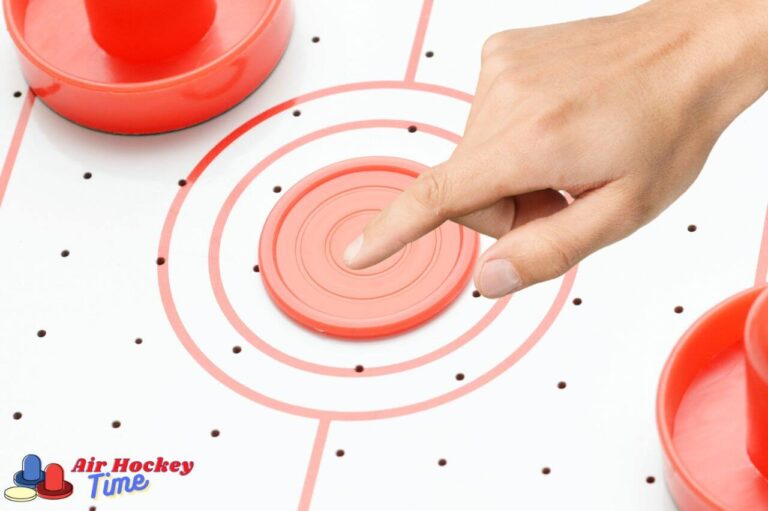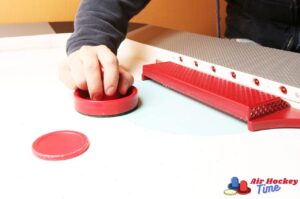In the dynamic world of air hockey, players must rely solely on their mallet-handling skills to maneuver the puck and outwit their opponents.
However, a specific action known as “palming” can lead to penalties and disrupt the game’s flow.
In this blog post, we will cover what exactly palming is in an air hockey game, why it’s illegal, and how to avoid being called for palming during your next match!
What is Palming in an Air Hockey Game, and Why Is It Called a Foul?
In an air hockey game, “palming” refers to making contact between any part of a player’s hand, arm, body, or clothing with the puck during gameplay.
It is called a foul because it goes against the established rules of the game.
Palming is a violation because it provides an unfair advantage, allowing a player to control or manipulate the puck using unauthorized means.
Air hockey rules strictly require using the mallet to interact with the puck.
The game emphasizes skillful mallet handling, quick reflexes, and strategic decision-making by prohibiting palming.
This rule ensures fair play, maintains the integrity of the game, and ensures that success in air hockey is determined by the players’ abilities rather than shortcuts or rule violations.

Understanding the Unwritten Rules of Air Hockey
Understanding the unwritten rules of air hockey goes beyond the official rulebook, delving into the nuances and codes of conduct that govern the game.
These unwritten rules are rooted in sportsmanship, fairness, and respect for the game and fellow players.
They include avoiding excessive body contact, refraining from intentionally obstructing the opponent’s view, and conducting oneself with grace and integrity.
Players are expected to adhere to an unspoken code that encourages friendly competition, mutual enjoyment, and a focus on skill and strategy.
Understanding the unwritten rules of air hockey contributes to a positive playing environment where players can engage in spirited matches while upholding the values and traditions associated with the game.
By following these unwritten rules, players enhance their experience and contribute to the overall sportsmanship and camaraderie within the air hockey community.
Common Causes of Palming in an Air Hockey Game
Palming, the act of making contact between any part of a player’s hand, arm, body, or clothing with the puck in an air hockey game, can occur for various reasons.
One common cause is a momentary lapse in concentration or a misjudgment of the puck’s trajectory, leading to accidental contact with the hand or body.
Rapid gameplay and the high speed of the puck can make it challenging to react swiftly and avoid palming violations.
Another cause can be the instinctive reaction to protect oneself, especially when the puck is heading toward the player’s face or body.
Players may instinctively use their hands or body to shield themselves in such cases, resulting in a palming foul.
Additionally, inexperienced players or those new to the game may unintentionally palm the puck due to a lack of familiarity with the rules and proper mallet-handling techniques.
Overall, preventing palming requires focus, practice, and a thorough understanding of the rules, ensuring players can navigate the fast-paced game without violating this vital aspect of fair play.
Avoiding Palming – Tips and Tricks to Stay on the Right Side of the Referee
Avoiding palming fouls in air hockey is crucial to maintain fair play and stay on the referee’s right side.
Here are some helpful tips and tricks to help you navigate the game without incurring palming penalties.
Firstly, ensure a firm grip on the mallet throughout the game. Practice holding it securely and maintaining control even during intense moments.
Keep your hands relaxed but stable, allowing for quick and precise movements.
Develop good hand-eye coordination to track the puck’s movement and anticipate its trajectory accurately.
Focus on using your mallet effectively to intercept and redirect the puck, minimizing the need for hand or body involvement.
Position yourself well, keeping your body and hands clear of the puck’s path.
You can significantly reduce the risk of accidental palming by maintaining an appropriate distance and proper body positioning.
Lastly, practice consistently and familiarize yourself with the rules of the game. Understand the boundaries and limitations of using your hands and body, ensuring you play within the established guidelines.
By implementing these tips and tricks, you can enhance your skills, minimize palming violations, and contribute to a fair and enjoyable air hockey experience for all players.
Frequently asked questions
Is there a strategy to air hockey?
Certainly! Air hockey is not just about quick reflexes and skilled maneuvering; it also involves strategic thinking and anticipation of your opponent’s moves.
Developing a strategic mindset can significantly enhance your performance in the game.
By observing your opponent’s playing style and tendencies, you can anticipate their next move, enabling you to position yourself effectively for scoring opportunities while simultaneously blocking their attempts.
A potent offense is crucial in air hockey, as it puts pressure on your opponent and increases your chances of scoring.
You can gain an advantage by focusing on offensive strategies, such as aiming for gaps in their defense or using controlled shots to create rebounds.
Balancing offensive prowess with defensive awareness is also crucial.
Positioning your striker in a way that covers your goal and blocks your opponent’s shots can help you maintain control and prevent them from scoring.
By employing a strategic approach, combining anticipation, offensive skills, and defensive awareness, you can improve your chances of success and increase your overall performance in air hockey.
Can you keep your mallet in front of the goal in air hockey?
Certainly! When playing defense in air hockey, it is advisable to position your mallet approximately 8-14 inches in front of the goal.
This strategic placement allows you to create a barrier between the puck and the goal, increasing your chances of making successful defensive plays.
However, it is essential to find the right balance in mallet positioning. Placing it too close to the goal may leave gaps that the opponent can exploit, while positioning it too far away may make it challenging to react quickly to incoming shots.
Finding the optimal distance and keeping your mallet in front of the goal can protect your territory, block shots, and maintain a solid defensive presence in air hockey.
In conclusion
In conclusion, “palming” in an air hockey game refers to making contact between any part of a player’s hand, arm, body, or clothing with the puck during gameplay.
It is considered a foul due to its violation of the established rules.
Understanding the concept of palming is crucial for players to maintain fair play and adhere to the principles of the game.
By prohibiting palming, air hockey emphasizes the importance of using the mallet for puck interaction, promoting skillful play, quick reflexes, and strategic decision-making.
By recognizing and respecting the rule of palming, players can ensure a level playing field, showcase their mallet-handling abilities, and enjoy a thrilling and competitive game that reflects the true spirit of air hockey.








